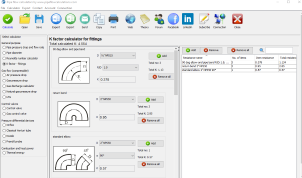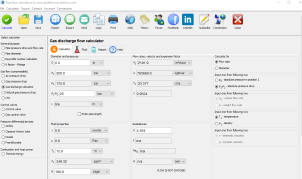Air flow calculator
calculation of air flow and pressure drop
Online Calculator
This calculator is not available as Online app.
Desktop App

Desktop full-featured version.
Free Trial AvailableRegistration
Select a fair price and enable the full service:
- Switch between metric and imperial units in one click
- Export calculation results in Word .docx or Excel .xlsx format
- Preview results on one place and copy/paste it in your favorite text editor
- Send results back to your email
- Support the future of this project
And even more... get access to the full set of 19 desktop calculators available for MacOS, Linux or Windows.
Full Year Service
Prepaid Monthly Cost
$2.50/month
Full year $29.95/year
When Should You Use This Air Flow and Pressure Drop Calculator?
This calculator is ideal for estimating air flow through pipelines or determining the pressure drop of air as it moves through a pipe. It supports round cross-section pipelines and is applicable to both laminar and turbulent flow conditions.
Calculator Limitations
This tool assumes isothermal flow, meaning the air temperature remains constant along the pipeline, even with pressure changes. This assumption holds when the pipeline is:
- Long and straight, with minimal cross-sectional changes
- Uninsulated and exposed to ambient conditions
In cases of slow or steady airflow, any cooling from pressure drop is naturally balanced by heat exchange with the surrounding environment. As a result, the air maintains a stable temperature during flow.
How Does the Calculator Work?
The calculation is based on the isothermal flow equation for an ideal gas. Here's what the calculator evaluates:
- 1️⃣ Friction factor (f) and local resistance coefficient (K)
- 2️⃣ Reynolds number (Re) to determine the flow regime (laminar or turbulent)
- 3️⃣ Air velocity at both the inlet and outlet of the pipe
- 4️⃣ Total pressure drop across the pipeline
You’ll receive detailed output showing the flow regime, Reynolds number, and velocities at both ends of the pipeline.
When Not to Use This Calculator
This tool does not support adiabatic flow conditions—where temperature changes due to significant pressure drops. It is not suitable for:
- Flows with large pressure drops (e.g., leaks, narrow openings, or sonic flow)
- Situations where altitude changes significantly affect air density
- Scenarios requiring potential energy changes due to elevation differences
These conditions invalidate the assumption of constant temperature and may require more advanced thermodynamic modeling.
Required Input Information
- 📌 To calculate pressure drop, you must enter the air flow rate
- 📌 To calculate air flow, you need to enter the expected pressure drop
- 📌 Accurate results depend on entering realistic and compatible values based on your specific pipeline configuration.
Register account and unlock full access
Desktop App

Fast. Accurate. Reliable.
Features in desktop app
- Save/Open multiple results
- Export to Word and Excel
- Print results
- Create list of custom fluid properties
- Resistance factor K for valves/fittings
- Pipe surface roughness selection
- Pipe material selection
- Gauge vs absolute pressure toggle
- Compressible isothermal flow
- Dry air isothermal flow
- Gas offtake flow
- Natural gas flow
- No admin rights required to install
Need a helping hand?
Powered by natural intelligence - NI

If you need a quick calculation, but you are not still familiar how to use the calculator, you can order calculation service from the calculator developer.






